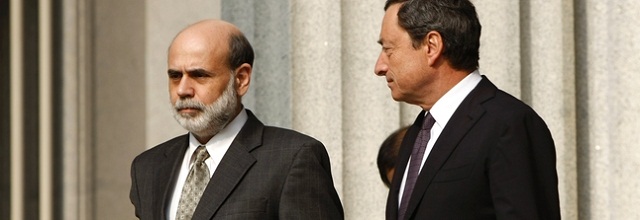The Federal Reserve announced it will keep interest rates between zero percent and 0.5 percent until unemployment figures fall down to 6.5 percent and while inflation does not increase above 2.5 percent. On top of this, it will extend its QE programme of monetary expansion–here there is the communiqué and some commentary.
What governor Bernanke has cunningly done, too, is upgrading the central bank’s inflation level tolerance by half a percentage point, while deleting the former deadline to introduce higher interest rates–it was 2015 before his last statement. Now, if the consumer price index remains above 2 percent, which has become a sort of minimum, the consequence will be none for interest rates.
Mr Draghi, governor at the European Central Bank, should listen to his American colleague. And follow suit, even though in Europe the inflation target could be closer to 4 percent than to 1.5 percent. But, unfortunately, no one dears to think about this in Frankfurt. The are completely wrong. By weakening the dollar, in fact, the Fed has just given a golden opportunity to the ECB to increase its monetary supply, and to do so in a coordinated way.
And this is what former Bank of Canada governor and future Bank of England’s boss said about the Fed’s move.
“Mr Carney, the current Bank of Canada governor who takes over from Sir Mervyn King next June, said central bankers should consider committing to low interest rates until inflation and unemployment met ‘precise numerical thresholds’, or even changing ‘the policy framework itself’ to stimulate a desperately weak economy.”
“His words were directed at the Bank of Canada but will be seen as a hint that he will push for radical action in the UK, where the economy has been stagnant for two years. On his appointment, he said that he would be going ‘where the challenges are greatest.'”
“Addressing the Chartered Financial Analyst Society in Toronto, Mr Carney said that in major slumps: ‘To achieve a better path for the economy over time, a central bank may need to commit credibly to maintaining highly accommodative policy even after the economy and, potentially, inflation picks up.'”
“To ‘tie its hands’, a central bank could publicly announce precise numerical thresholds for inflation and unemployment that must be met before reducing stimulus.”
“He added: ‘If yet further stimulus were required, the policy framework itself would likely have to be changed. For example, adopting a nominal GDP level target could in many respects be more powerful than employing thresholds under flexible inflation targeting.'”






Be the first to comment on "US Federal Reserve’s historical decision"